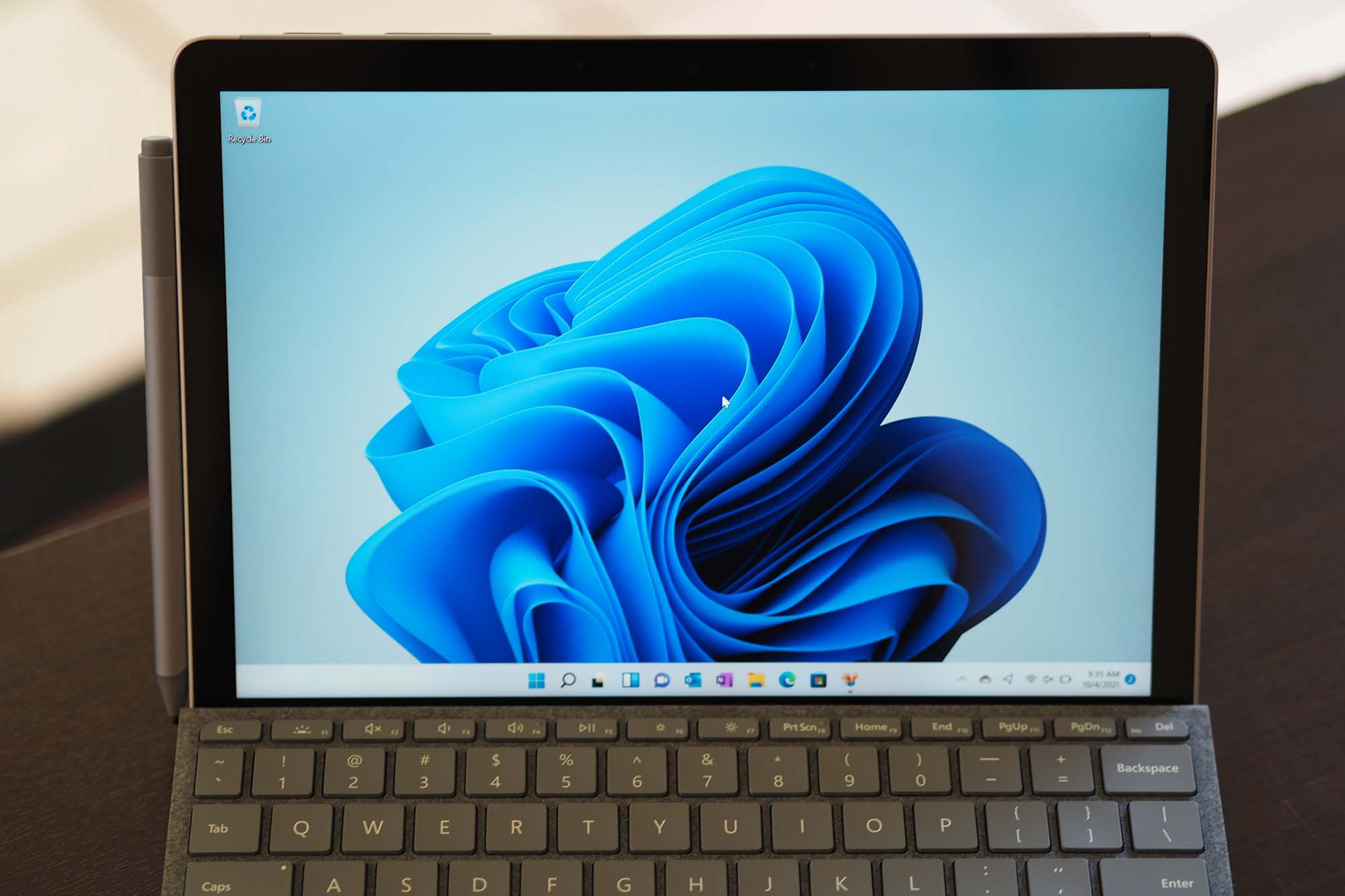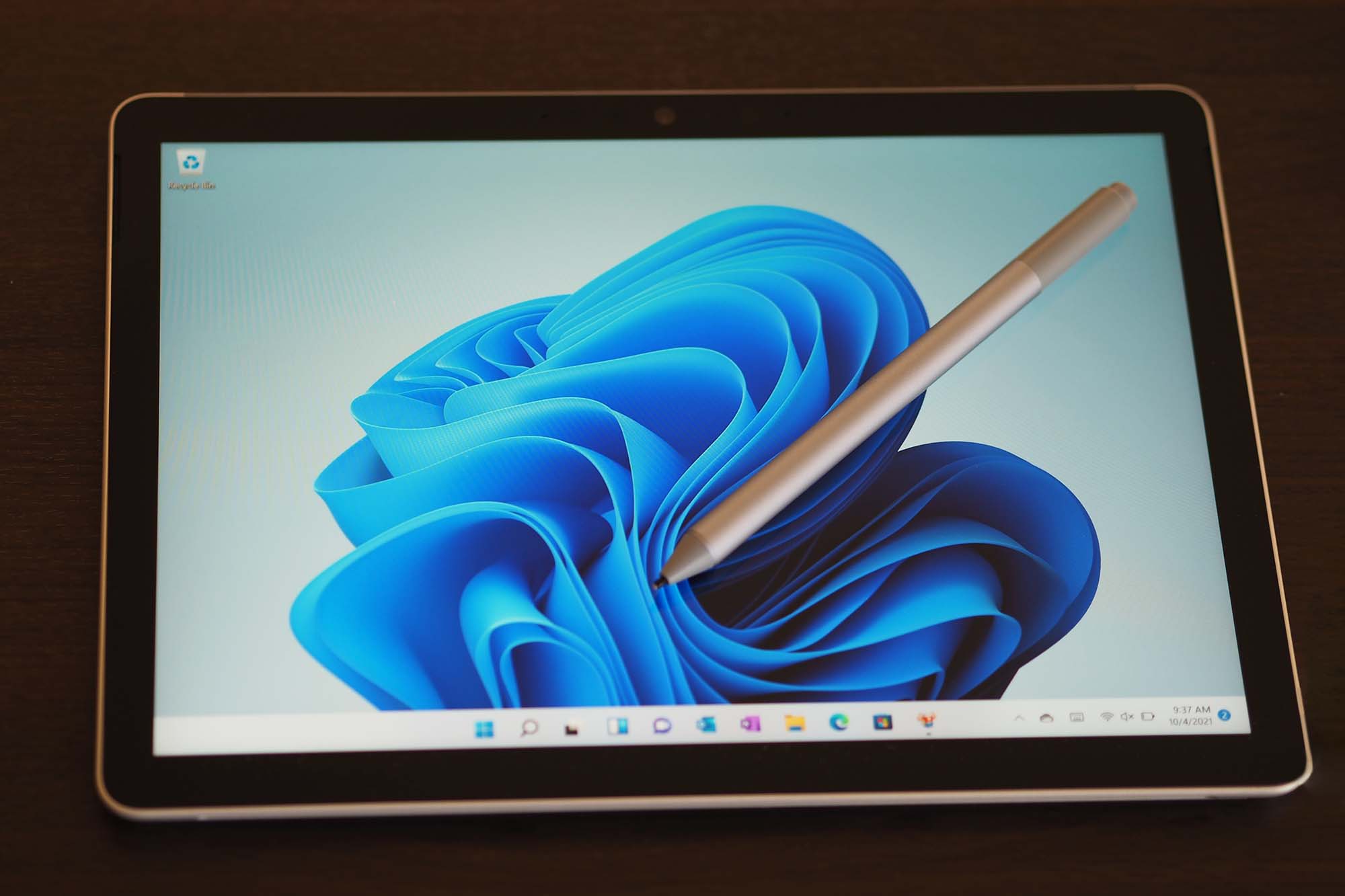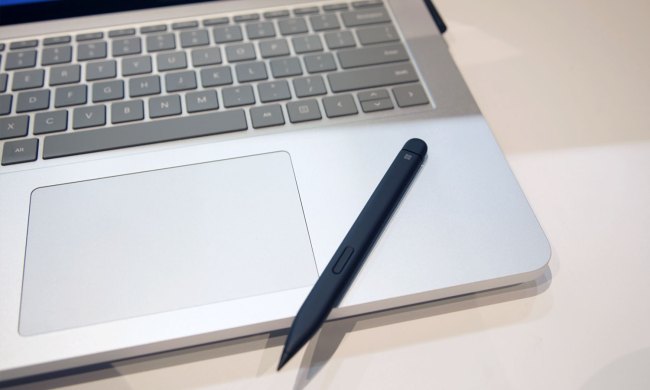- Excellent build quality
- Superior display for a budget machine
- Great Active Pen support
- Small and light
- Surprisingly good real-world performance
- Can get expensive
- Mediocre battery life
- Keyboard and touchpad are cramped
The third generation is usually when Surface products start coming into their own.
The Microsoft Surface Go is the smallest and least expensive Surface you can buy — the Surface Go 2 has landed on our lists of best budget laptops and best 2-in-1s. It thumbs its nose at the Surface line’s usual premium status while still offering a lot of what makes the Surface so attractive.
I reviewed the high-end configuration of the Surface Go 3, with a 10th-gen Intel Core i3-10100Y CPU that Microsoft claims will make it significantly faster than the previous generation. This configuration costs $630 with 8GB of RAM and 128GB of solid-state storage (SSD) — not all that cheap when compared with a budget field that’s been steadily improving over the years. While the Surface Go 3 doesn’t quite live up to its promise of significantly improved performance, it still has its charms.
Design

Especially at its starting price of $399, the Surface Go 3 is an impressively built tablet. It’s constructed of magnesium and has a soft but solid feel that shows it was clearly manufactured to meticulous tolerances. It’s far better built than most budget laptops and matches the $329 Apple iPad while vastly exceeding the $279 Lenovo IdeaPad Duet. In fact, I’d hold the Surface Go 3’s build quality up there with the Lenovo ThinkPad X12 Detachable, which starts at over $1,000.
In terms of its aesthetic, think of a Surface Book 7, only smaller. The Surface Go 3 is the same color and shape, has corners that are a little more rounded but still familiar, and it shares the oversized bezels of its larger sibling. Even the eminently usable kickstand is similar, flipping out from the back center of the chassis and extending to a comfortable angle for using the (unfortunately) optional Surface Pen. It’s a modern device in all ways except those large bezels, which look old-fashioned compared to many current laptops.

While the Surface Go 3 is a small device, it’s not as small as it might have been with smaller bezels. Even so, it’s almost identical in size at 9.65 inches by 6.9 inches to the iPad (9.8 inches by 6.8 inches, with its own large bezels at each end). And the Surface Go 3 has a larger 10.5-inch display compared to the iPad’s 10.2-inch panel. It’s thicker, though, at 0.33 inches, than the iPad at 0.29 inches. Some of that extra thickness is most likely to accommodate the integrated kickstand. The Surface Go 3 is also a bit heavier than the iPad at 1.2 pounds versus 1.09 pounds.
Connectivity is limited, as you might imagine with such a small and thin machine. You get a single USB-C port, a 3.5mm audio jack, the Microsoft Surface Connect port for power and connecting to a proprietary hub, and a microSD card reader. Wi-Fi 6 and Bluetooth 5.0 perform wireless duties.
Performance

While the Surface Go 3 offers an Intel Core i3-10100Y CPU that’s a step up from the previous generation’s 8th-gen Core m3-8100Y, it doesn’t benchmark that way. It barely beats out its predecessor (we’ll get to that in a moment) in objective tests, and yet weirdly enough, subjectively, the Surface Go 3 doesn’t feel so slow.
I haven’t used the Surface Go 2, so I can’t directly compare the two, but the Surface Go 3 kept up just fine with most of the tasks I threw at it. That surprised me because I was expecting it to feel a lot slower. If I didn’t open too many tabs in Edge or have too many apps running in the background, the Surface Go 3 performed as well as many other budget laptops I’ve used.
Sure, some things are slower — viewing an email takes an extra fraction of a second, opening Edge with several default tabs suffers from some additional initial loading times, and opening new apps with a full complement of running programs was a little laggy. But overall, I was impressed with the Surface Go 3’s subjective performance. It’s not as quick as an iPad, but then again, it’s running a full-featured operating system in Windows 11. Speaking of that, the Surface Go 3 comes configured in Windows 11 S Mode, which limits apps to those available in the Windows Store. To install our test suite, I switched out of S Mode, which was trivial.
You can get work done with the Surface Go 3; just temper your expectations when it comes to moderate to heavy workloads.
Now to those benchmarks. In Geekbench 5, the Surface Go 3 managed a disappointing 920 in single-core mode and 1,704 in multi-core mode. Those are some of the slower results in our database and barely ahead of the Surface Go 2’s 868 and 1,626. We don’t have any comparisons with this particular CPU, but even Chromebooks running the Android Geekbench 5 app with similar processors are twice as fast. In our Handbrake test that encodes a 420MB video as H.265, the Surface Go 3 took a lethargic 612 seconds, just nine seconds faster than the Surface Go 2. Those are the two slowest machines in our database. The next slowest laptop is the Lenovo Yoga C640 running a Core i3-10110U, which took 397 seconds to complete the process.
I ran PCMark 10, and the Surface Go 3 scored 2,611 in the Complete test, the lowest score in our database and well under the next lowest. We haven’t tested many comparable laptops since we started using that benchmark, however. The Surface Go 3’s scores were low across the board, including the Essentials, Productivity, and Content Creation portions. The latter score was abysmal.
As I said above, however, real-world performance is better than these benchmarks suggest. You can get work done with the Surface Go 3; just temper your expectations when it comes to moderate to heavy workloads.
| Geekbench 5 (single/multi) | Handbrake (seconds) |
PCMark 10 | 3DMark Time Spy | |
| Microsoft Surface Go 3 (Core i3-10100Y) | 920 / 1704 | 612 | 2611 | 320 |
| Microsoft Surface Go 2 (Core m3-8100Y) | 868 / 1626 | 621 | N/A | N/A |
| Lenovo ThinkPad X12 Detachable (Core i5-1130G7) | 1352 / 4796 | 185 | 4443 | 926 |
| Microsoft Surface Pro 7 (Core i5-1035G4) | 1237 / 4455 | N/A | N/A | 487 |
| Acer Aspire 5 2021 (Core i3-1115G4) | 1215 / 2544 | 300 | 3752 | 652 |
The Surface Go 3 uses Intel UHD 615 graphics, and it’s not more than a casual gaming system — and by that, I mean simple Windows 10 games like Solitaire and the like. It scored a pathetic 320 in the 3DMark Time Spy benchmark, which again is one of the lower scores we’ve seen. I ran Fortnite just for giggles, and it was a slideshow at four frames per second at 1280p and high graphics.
Display
In typical Surface fashion, the Surface Go 3 has a display with a taller 3:2 aspect ratio that makes it exceptionally comfortable to use as a tablet in portrait mode — it’s closer to the dimension of a sheet of paper compared to 16:9 displays that are too tall and skinny. It’s a 10.5-inch display at 1,920 x 1,280 resolution, which is sharp enough even for someone like me who prefers 4K displays. Thanks to its brightness and high contrast, I enjoyed using a display that produces black text that jumped off the page.
My colorimeter backed me up. Simply put, this is an excellent display for a tablet that starts at $399. Colors were right at the premium laptop average of 75% of AdobeRGB and 99% of sRGB, which is more than enough for comfortable productivity work, even if not as wide as creative types are looking for. And color accuracy was also very good at a DeltaE of 1.21 (1.0 or less is considered excellent), exceeding the premium average. The contrast ratio was 1,360:1, well above our preferred 1,000:1 threshold, and brightness was excellent at 434 nits (again, well above our desired level of 300 nits).
The Surface Go 2 had slightly wider colors at 77% of AdobeRGB and 100% of sRGB, but they were less accurate at 2.21. Brightness was also lower at 342 nits, and the contrast ratio was a disappointing 730:1. Microsoft upped its game with this display. The much more expensive Lenovo ThinkPad X12 Detachable had lesser colors at 72% and 97%, respectively, and they were a bit less accurate at 1.59. It wasn’t as bright at 364 nits, and its contrast ratio was lower at 940:1.
I’m impressed with the display. It’s objectively superior to many laptops that cost three times as much, and it was a joy to use during my review.
Two forward-firing speakers provide the audio, and although the volume doesn’t get that high even when turned all the way up, the sound is remarkably clear. Mids and highs are crystal clear, and there’s even a touch of bass. I was particularly impressed with dialogue in TV shows and movies. You can use these speakers for binging Netflix if you want, as long as you’re okay with middling volume.
Keyboard and touchpad

The biggest problem with Microsoft’s Type Cover — which applies to all Surface tablets — is that it’s not included. You have two options for the Surface Go 3, the standard $100 Type Cover that comes in Black or the $130 Signature Type Cover that’s covered in (quite comfortable) Alcantara fabric and available in Ice Blue, Platinum, and Poppy Red. My review unit came with the Ice Blue Signature Type Cover, bringing the cost to $760. I’ll go ahead and note that the Surface Pen isn’t included either, and that’s another $100 — bringing the total review package to $860, which is too high.
The next most significant problem with the Type Cover is its size. There’s nothing that Microsoft could have done about it, of course, given the Surface Go 3’s miniature stature, but the keys are tiny and there’s too little spacing. It’s a cramped experience that takes some getting used to. I wrote this review using the Surface Go 3, so even fast touch typists can become comfortable with the keyboard, but there’s a distinct learning curve. Note as well that the top row of letter keys are slightly off-center, and extremely sensitive typists might find that to be another adjustment. However, there’s a decent amount of travel and the key switches are snappy, if a bit loud, making the keypresses themselves precise and consistent. The Type Cover has a little bit of bounce, but it’s not terrible.
The touchpad is small but has a quiet clickiness, and thanks to Microsoft Precision Touchpad drivers, it’s responsive and accurate. I did find the size a hindrance at times, but overall, the experience was acceptable. The touch display is responsive, and the Surface Pen supports its full 4,096 levels of pressure sensitivity and tilt support. The Surface Go 3 makes for an excellent notetaking device thanks to its small size and weight.
An infrared camera and facial recognition provide windows 10 Hello password-less login support. It was fast and reliable, and it engages when you open the Type Cover. There’s no way to block or turn off the webcam, which is an increasingly common privacy feature.

Battery life
Packed inside the tiny Surface Go 3’s chassis is a 28 watt-hour battery. That’s not huge, even for a laptop with low-end components and a small display. Even so, I was expecting better battery life than I saw.
Overall, I’d have to rate battery life as mediocre at best.
In our web-browsing test, the Surface Go 3 lasted for just 5.5 hours, about half of what we prefer to see in a laptop. That’s 40 minutes longer than the Surface Go 2, which is a definite improvement, but the Lenovo IdeaPad Duet lasted for 13.7 hours and the iPad can be expected to last around 10 hours. The Surface Go went for a more robust 11.45 hours in our video-looping test that uses a local Full HD Avengers trailer. That’s close to the Surface Go 2’s 11.25 hours and about an hour less than the IdeaPad Duet. It’s likely to exceed the iPad’s longevity, and it’s more in line with what other budget laptops achieve.
In the PCMark 10 Applications battery test, probably the best indication of productivity longevity, the Surface Go 3 made it to about 6.5 hours, which is a low score that indicates you’re not likely to get a full day’s work out of the laptop. Most of the machines we’ve tested have lasted for about twice as long. I also ran the PCMark 10 Gaming battery test, where the Surface Go 3 lasted for just over two hours. That’s about average, and this test seems to demonstrate how hard a laptop works while on battery.
Overall, I’d have to rate battery life as mediocre at best. Again, you’re not likely to get through a full working day without plugging in unless you’re watching video. The results add credence to the notion that the Surface Go 3 is best as a secondary machine rather than a primary workhorse.
Our take

When I started this review, I fully expected to dislike the Microsoft Surface Go 3. The keyboard is small and cramped, its benchmark numbers aren’t good, and those two factors combined to give me a bad first impression. That didn’t last, though, as I adjusted to the keyboard and the Surface Go 3’s real-world performance exceeded its benchmark results.
As I worked through my review, I found myself liking the little tablet quite a bit. It’s a great size for casual use anywhere, I found myself enjoying handwriting on the Surface Go 3 more than I have on many larger 2-in-1s, and the performance was good enough that I didn’t notice meaningful slowdowns. Of course, I’m describing casual or mainstream productivity workflows here — nothing at all demanding — and I wouldn’t suggest it for more than browsing the web, triaging email, running Office apps, and streaming media. Don’t expect to hook it up to an external display and use it as your main machine.
For all those things, though, it’s a great device. It’s a little expensive at $860 when fully configured with the fastest CPU, the Type Cover, and the Surface Pen — and that’s a knock against it. I can’t attest to its performance with the Pentium CPU alternative, and so I don’t know if saving money will give you performance issues. But if you want a device that’s easy to carry around and comfortable to use, then the Surface Go 3 can fit the bill.
Are there any alternatives?
The most notable alternative is the Apple iPad — the entry-level model that starts at $329. It has a great display, solid performance running iPad OS, and millions of (mobile) apps. You can do all the same things with it and enjoy faster performance. But you might miss the complete feature set of Windows 11.
You could also step up in size and price and select the Surface Pro 8. We’re in the process of reviewing that detachable tablet and fully expect it to be a real step up from the Surface Pro 7. It’ll be faster and longer lasting, and will also offer a larger display and keyboard.
Finally, you could save some cash and go with the Lenovo IdeaPad Duet if you’re good with Chrome OS. That tablet provides reliable performance and a nice display, but it’s not as well-built. And again, you’ll have to be OK with giving up a “real” operating system.
How long will it last?
The Surface Go 3 is exceptionally well-made and should last for years. Whether its performance keeps up depends entirely on how Microsoft tunes Windows 11, but considering that Windows 10 never really slowed down, I’d expect years of good-enough performance. There’s a one-year warranty, which is standard and makes sense at this price point.
Should you buy it?
Yes. If you want Windows 11 in a smaller tablet that’s easy to carry around and can handle your less strenuous workflows, then the Surface Go 3 is a great choice.





